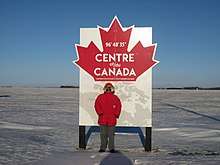Centre of Canada
There are several ways of determining the centre of Canada giving different locations.
- There is a sign on the Trans-Canada Highway at 96°48'35"W (slightly east of Winnipeg) proclaiming it the longitudinal centre of Canada;[1] in effect, the north-south line midway between the extreme points of Canada on the east and west, including islands (including Newfoundland since 1949). This is 20 minutes west of the location given by the Atlas of Canada, however. See also: 96th meridian west and 97th meridian west.

Sign on the Trans-Canada Highway near Winnipeg, marking the longitude centre of Canada
- The latitudinal centre of Canada (including islands, but excluding Canada's claim to the North Pole) is a line at 62 degrees 24 minutes North. See also: 62nd parallel north
- The intersection of these two lines is one definition of the centre of Canada, as explained by the Atlas of Canada's website:
The centre of Canada can be measured in many ways. The most readily understood would be by taking the mid-point of the extremities of the Canadian landmass section, above. The resulting location 62°24′N 096°28′W is located just south of Yathkyed Lake in Nunavut, west of Hudson Bay. - The Atlas of Canada website, Natural Resources Canada[2]
The nearest inhabited places to this point are Baker Lake, Nunavut well to the north, and Arviat to the east.
- The pole of inaccessibility of Canada (the point furthest from any coastline or land border) is near Jackfish River, Alberta at 34-115-17-W4 (Latitude: 59°2′ 60 N, Longitude: 112°49′ 60 W). (Pole of inaccessibility says 59 1 48 and 112 49 12.)
References
External links
This article is issued from Wikipedia. The text is licensed under Creative Commons - Attribution - Sharealike. Additional terms may apply for the media files.